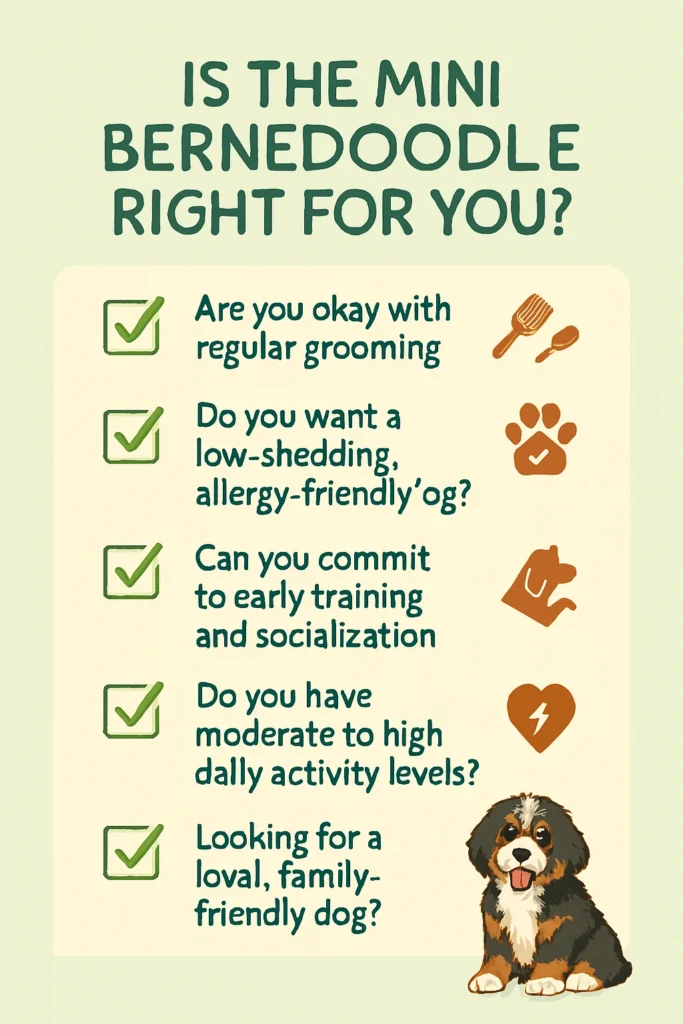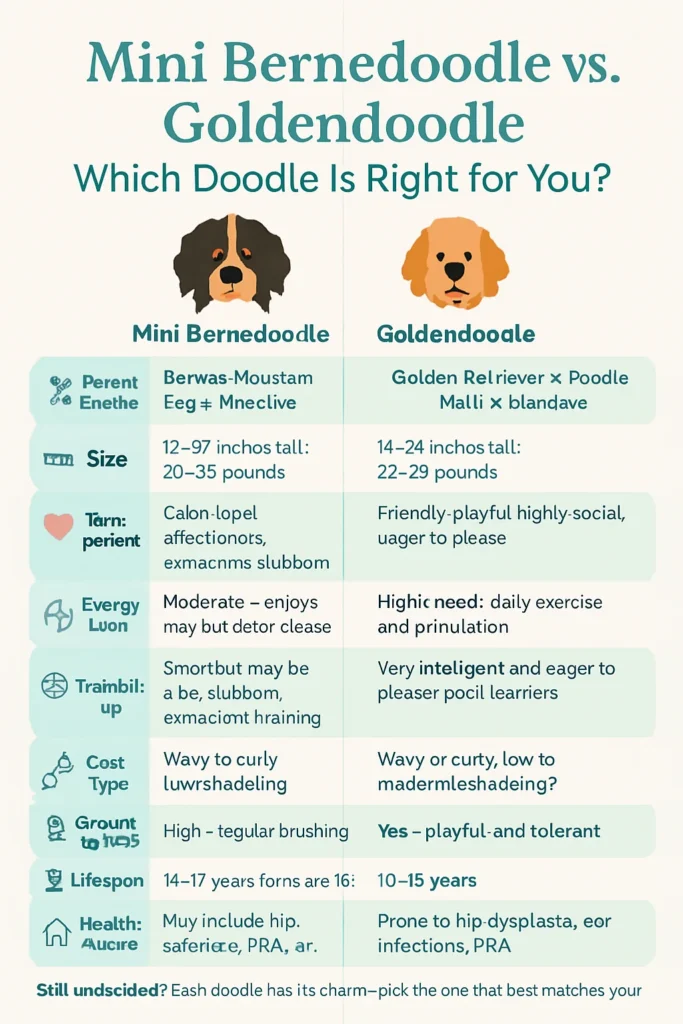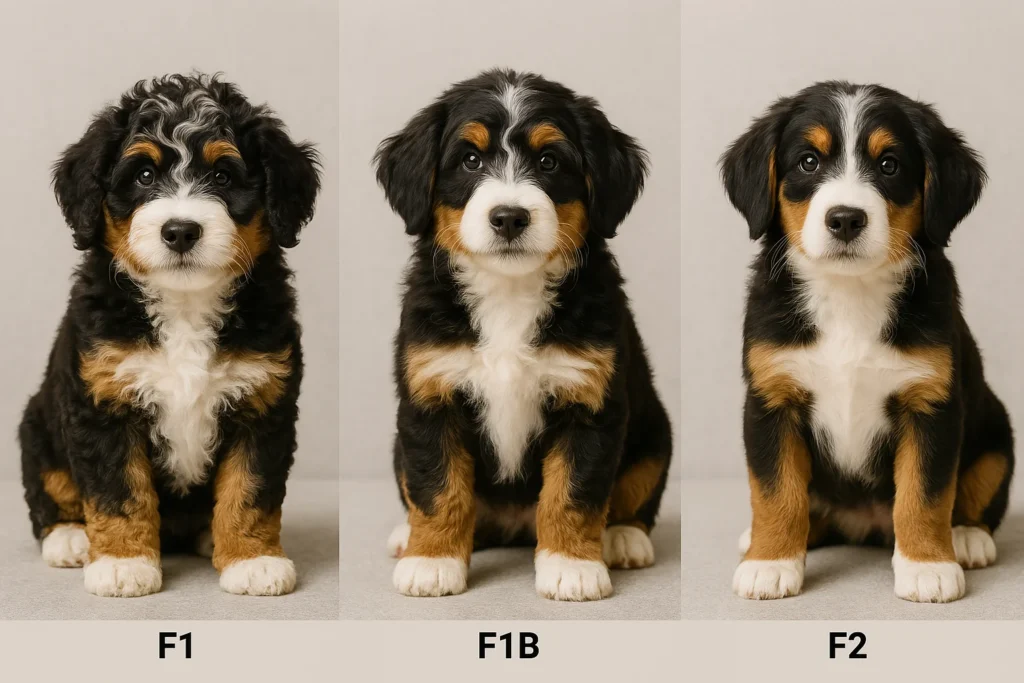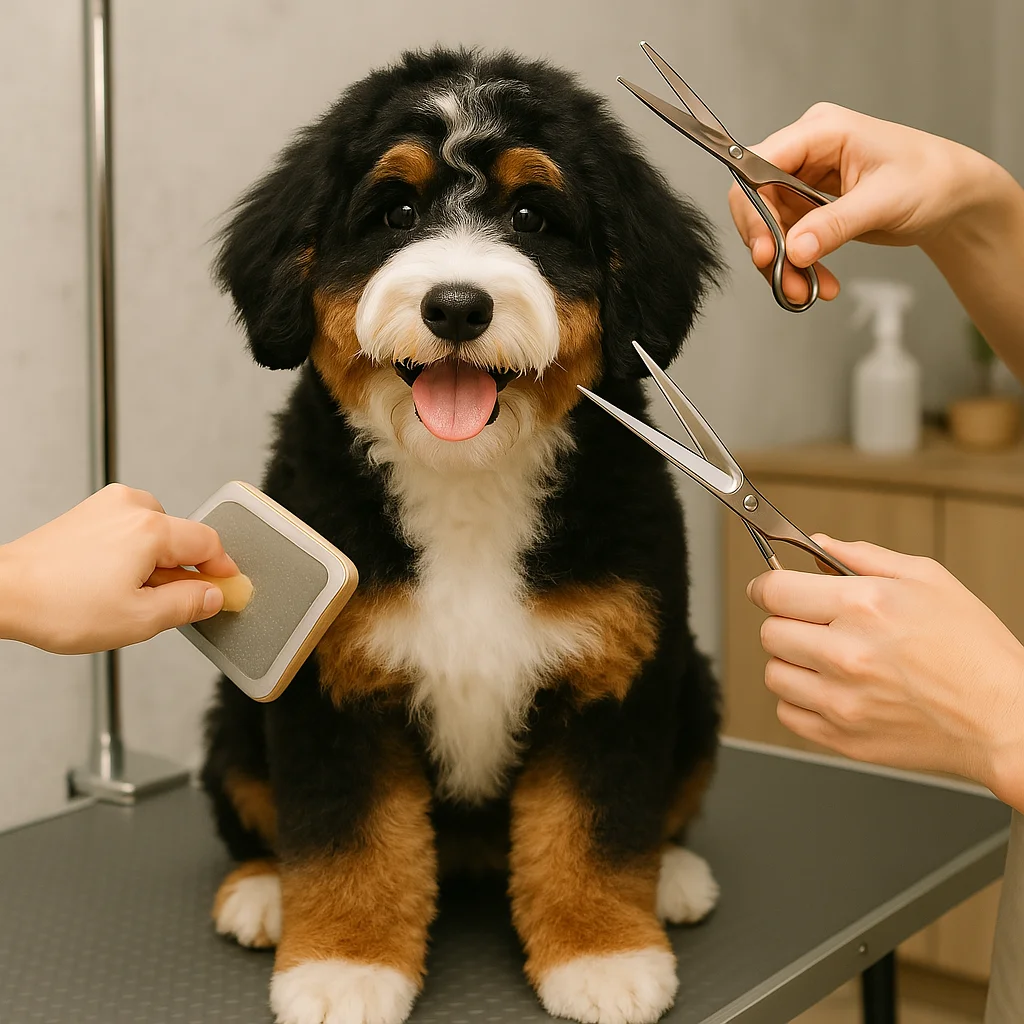Looking for a dog that can keep up with your kids all afternoon, and then, curl up at your feet like a living teddy bear when the house is finally quiet? Indeed, that’s the heart of a Mini Bernedoodle. They have a gentle, affectionate nature that can soothe you after a long day. Moreover, and the best part for many families is that their curly, allergy-friendly coat means more cuddles and fewer sneezes.

But it’s more than just their adorable looks. Behind those soulful eyes is a smart, goofy, and incredibly loyal friend who will stick by your side. In fact, they aren’t just a pet; they are a devoted companion that brings a special kind of joy and laughter into a home.
Is a Mini Bernedoodle Right for You?
It’s easy to fall for those sweet, soulful eyes. However, before you start browsing breeders or rescues, take a breath. To clarify, is a Mini Bernedoodle truly the right companion for your life and routine? Let’s walk through a quick checklist to find out.
Checklist
- Do you have time for regular grooming?
- Are you ready for consistent training and socialization?
- Is your lifestyle active enough for their exercise needs?
- Can you handle potential health issues?
- Are you ready to take on the responsibilities of caring for a pet over the years?

Suggestion: If you can honestly agree with all these points, a Mini Bernedoodle might be the perfect match for you.
What Is a Mini Bernedoodle?
The Mini Bernedoodle isn’t just any mixed breed. Specifically, it’s a carefully crafted designer dog, created by crossing the clever Miniature Poodle with the gentle giant Bernese Mountain Dog. Breeders wanted to combine the Bernese’s sweet, loyal nature honed from generations of hard work on Swiss farms with the Poodle’s sharp intellect, easy trainability, and hypoallergenic, low-shedding coat. Usually tipping the scales between 20 and 45 pounds. However, Mini Bernedoodles are smaller than their standard Bernedoodle cousins but bring just as much heart and personality.
Also Known As
- Bernedoodle Mini
- Miniature Bernedoodle
- Micro or Tiny Mini Bernedoodle (very small variant)
Popularity Highlights
- Frequently considered hypoallergenic (especially F1B generations)
- Low to minimal shedding
- Smart, playful, and suited for families or singles with active lifestyles
History & Generations of Mini Bernedoodles
The Mini Bernedoodle is a relatively new star in the world of designer dogs, first appearing in North America around 2003. It was the inspired creation of dedicated breeders who set out to combine the best qualities of two beloved breeds: the intelligent Miniature Poodle and the affectionate Bernese Mountain Dog.
Over time, breeders have carefully refined the Mini Bernedoodle’s temperament, coat texture, and size ensuring that this charming hybrid remains adaptable, loving, and perfectly suited to today’s modern homes and lifestyles.
Mini Bernedoodle Generational Types
Understanding the different generations of Mini Bernedoodles can help you choose the perfect pup based on coat type, shedding, and personality. For example, here’s a quick breakdown.
F1 (First Generation)
- Genetic Makeup: 50% Miniature Poodle crossed with 50% Bernese Mountain Dog
- Coat & Shedding: Wavy or loose curls; moderate shedding
- Temperament: Balanced mix of both parent breeds
- Best for: Families who want a classic hybrid with a blend of traits
F1B (First Generation Backcross)
- Genetic Makeup: 75% Miniature Poodle and 25% Bernese Mountain Dog
- Coat & Shedding: As a result, curly, low-shedding coat, ideal for allergy-prone owners
- Temperament: More Poodle-like, smart, playful, and easier to train
- Best for: Allergy-sensitive families or those desiring lower maintenance grooming
F2 / F2B / F1BB (Multigenerational Mixes)
- Genetic Makeup: Combination of Bernedoodles or further backcrosses with Poodles
- Coat & Shedding: Highly variable, can be curly, wavy, or straight
- Temperament: More predictable with refined traits and consistent personality
- Best for: Owners looking for specific coat types, colors, or sizes
Pro Tip: If you have allergies or just want a pup with a predictable coat and low-shedding routine, F1B and F2B Mini Bernedoodles are great picks.
Mini Bernedoodle Appearance & Coat Types
Mini Bernedoodles truly shine with their beautiful variety of coat textures and colors, making each one uniquely charming:
- Texture: Mini Bernedoodles usually have soft wavy or curly coats, tends to be more allergy-friendly, making them a great pick for sensitive owners. However, straighter coats are less common and usually appear in first-generation dogs.
- Color Variations: You’ll find Mini Bernedoodles showing off a stunning palette, including:
- The timeless classic tri-color mix of black, white, and rust
- Eye-catching blue merle or phantom merle patterns
- Warm chocolate, soft cream, and vibrant apricot shades
- Gorgeous bi-color combinations or solid black and white coats
Size, Weight & Lifespan of Mini Bernedoodles
In fact, Mini Bernedoodles come in a few different size categories, mostly influenced by the size of their Poodle parent, so you can find the perfect fit for your lifestyle and living space:
| Variant | Height (inches) | Weight (lbs) |
| Micro or Tiny Bernedoodle | 12–17 | 10–25 |
| Mini Bernedoodle | 18–22 | 25–40 |
| Standard Bernedoodle | 23–29 | 40–60+ |
When it comes to lifespan, smaller usually means longer!
- Tiny Bernedoodles frequently reach a cheerful old age of up to 18 years.
- The slightly bigger Minis typically enjoy a healthy lifespan of 14 to 17 years.

Mini Bernedoodle Temperament and Personality Traits
So, what are Mini Bernedoodles really like to live with? Let’s dive into their personality. Mini Bernedoodles are truly the definition of lovable companions, known for their warm, friendly, and wonderfully adaptable personalities:
- Family-Friendly: Additionally, they’re gentle and patient with children, yet just as affectionate and loyal to adults.
- Highly Intelligent: These pups catch on fast! Whether it’s basic obedience or fun tricks, their sharp minds make training feel like a breeze.
- Emotionally Attuned: Interestingly, they’re little empaths, often tuning into your moods and offering comfort when you need it most.
- Moderate Energy: Playful and lively enough to keep things fun indoors, but not so hyperactive that they’re bouncing off the walls.
- Protective Instinct: They have a natural alertness and loyalty that will keep your home feeling safe without being aggressive or overbearing.
Real-Life Story: How Maia Changed Everything
In Toronto, the Connors family found more than just a pet when they brought home Maia, their F2B Mini Bernedoodle. Their five-year-old son, who struggled with anxiety, began to calm down thanks to Maia’s gentle, intuitive nature. She would quietly curl up beside him during emotional moments, offering comfort without needing a word.
According to their account shared on Swissridge Kennels’ testimonial page, in fact, Maia not only learned impressive commands like “stay,” “reverse,” and “place,” but she’s now on her way to becoming a certified service dog, proof that the right dog can change a family’s life.
Mini Bernedoodle vs. Goldendoodle

| Feature | Mini Bernedoodle | Goldendoodle |
| Parent Breeds | Bernese Mountain Dog × Miniature Poodle | Golden Retriever × Poodle
(Mini or Standard) |
| Size | Stand 18–22 inches tall and weigh between 20–45 pounds | Range from 17–24 inches and can weigh around 25–55 pounds |
| Temperament | Calm, loyal, affectionate, sometimes stubborn | Friendly, playful, highly social, eager to please |
| Energy Level | Moderate – enjoys play but also relaxes | High – needs daily exercise and stimulation |
| Trainability | Smart but may be a bit stubborn; consistent training helps | Very intelligent and eager to please; quick learners |
| Coat Type | Wavy to curly; low-shedding | Wavy or curly; low to moderate shedding |
| Grooming Needs | High – regular brushing and grooming required | High – requires consistent grooming to avoid matting |
| Good with Kids? | Yes – patient and gentle | Yes – playful and tolerant |
| Lifespan | 14–17 years (some up to 18) | 10–15 years |
| Health Issues | May include hip dysplasia, PRA, skin sensitivities | Prone to hip dysplasia, ear infections, PRA |
| Best For | Families who want a loyal, gentle dog with moderate energy | Active families who enjoy an outgoing, playful companion |
Health Issues and Lifespan Overview Of
Mini Bernedoodle
Mini Bernedoodles are generally strong and healthy. However, like all dogs, they can inherit certain health issues from their parent breeds. It’s important to be aware of these common concerns so you can keep your furry friend happy and thriving:
- Hip & Elbow Dysplasia: Joint issues that can affect mobility, so maintaining a healthy weight and regular vet check-ups are key.
- Eye Conditions: Including progressive retinal atrophy (PRA) and cataracts, which may impact vision over time.
- Allergies & Skin Irritations: Some pups can develop sensitivities, so watch for itching or redness and consult your vet if needed.
- Less Common Issues: Such as bloat or certain types of cancers, which are rarer but still worth knowing about.
Pro health tip: Request genetic test results (like OFA or Embark) from your breeder to confirm the puppy’s parents are free from major hereditary issues.
Grooming Tips for Mini Bernedoodle Dogs
Keeping their coat in great shape is key. Let’s take a look at grooming habits that work best.
- Brushing: Ideally, brush your Mini Bernedoodle 3 to 4 times a week to prevent tangles and mats.
- Professional Grooming: Every 6–8 weeks is ideal for trimming and pampering.
- Bathing: Every 4–6 weeks, or whenever your furry friend needs a refresh.
- Nail Trimming: Monthly trims keep those paws comfy and prevent overgrowth.
- Ear Cleaning: Biweekly checks help avoid infections, especially with their floppy ears.
- Dental Care: Daily brushing is recommended to keep that smile bright and breath fresh.
- Best Food for Mini Bernedoodles: Choosing the best food for Mini Bernedoodles is essential to maintain their energy and coat health.
- Look for high-quality kibble rich in protein and omega-3 fatty acids
- Grain-free diets or raw food options may also work well
Mini Bernedoodle Exercise Needs & Mental Stimulation
Beyond grooming, Mini Bernedoodles need to stay active. How much exercise do they really need? Let’s dive in:
- Daily Exercise: 45–60 minutes of movement keeps them fit and satisfied.
- Fun Activities: Walks around the neighborhood, hikes in the woods, off-leash park time, fetch games, and agility courses all hit the spot.
- Mental Challenges: Puzzle toys, obedience games, learning new tricks, and socializing keep their clever minds sharp and prevent boredom.
Mini Bernedoodle Training & Socialization Tips
One of the best things about Mini Bernedoodles? They’re quick learners who love to make you happy, turning training into a rewarding experience. Of course, even the best temperament needs guidance. Here’s how training fits in:
- Start Early: Begin crate training and potty training as soon as your pup arrives home.
- Use Positive Reinforcement: Treats, toys, and lots of praise go a long way.
- Socialize Often: Introduce your dog to new people, pets, and environments regularly to build confidence and good manners.
- Practice Calm Separation: Help prevent separation anxiety by gradually teaching your pup to enjoy alone time.
Pro Tip: Ongoing training keeps Mini Bernedoodles mentally sharp and deepens your connection, thanks to their eager-to-learn nature.
Family Compatibility Of Mini Bernedoodles
Mini Bernedoodles make wonderful family members and companions for a wide range of lifestyles. They’re especially great for:
- Families with children who want a gentle and playful friend
- Homes with other pets who appreciate a sociable buddy
- Active singles or couples looking for an energetic, affectionate companion
Note: They might not be the best fit if you’re away from home long hours or travel frequently.
Adoption vs. Buying a Mini Bernedoodle: A Smart Decision Guide
No matter which route you take, adopting or buying. Choose what aligns best with your lifestyle, values, and resources, and enjoy the incredible journey ahead!
| Aspect | Adoption | Buying from a Breeder |
| Initial Cost | $150–$600 | $2,000–$5,000 |
| Where to Get One | Animal shelters or breed-specific rescues (e.g., Mini Bernedoodle Rescue California) | Reputable breeders specializing in Mini Bernedoodles |
| Why Choose This Path | You’re giving a dog a second chance at a loving life | Offers predictability in coat, size, temperament, health, and early training |
| Price Influencers | Not applicable | Coat type, generation (F1, F1b, etc.), breeder reputation, size, rare colors |
Name Ideas for Your Mini Bernedoodle
Whether you’re drawn to their cuddly curls, playful energy, or Swiss heritage, these names are sure to match their charm!
| Category | Name Ideas |
| Male Names | Teddy, Milo, Baxter, Finn, Oliver, Winston, Jasper |
| Female Names | Luna, Daisy, Bella, Ruby, Zoe, Willow, Piper |
| Swiss-Inspired | Alps, Heidi, Bruno, Zermatt, Geneva, Klaus, Yodel |
| Cute & Quirky | Snickers, Waffles, Noodle, Mochi, Tofu, Doodle, Bubbles |
| Nature-Inspired | Maple, River, Aspen, Clover, Stormy, Pebble, Sunny |
FAQs
Still curious? Here are some of the most common questions future Mini Bernedoodle parents ask.
1. Are Mini Bernedoodles hypoallergenic?
Generally speaking, Mini Bernedoodles, particularly F1B and F2B, are usually hypoallergenic, but since no dog is completely allergy-free, it’s best to interact with one before committing.
2. How big do Mini Bernedoodles get?
Typically, they weigh 20–45 lbs and stand 18–22 inches tall. Meanwhile, “Micro” or “Tiny” varieties range from 10–25 lbs.
3. How Much Do Mini Bernedoodles Cost?
Generally, expect to pay $2,000–$4,000. That said, rare colors like tri-color or merle may cost more.
4. How much exercise do Mini Bernedoodles need?
On average, this breed requires about 45–60 minutes of daily physical activity, including walks, playtime, and mental stimulation to stay happy and healthy.
5. What is the typical lifespan of a Mini Bernedoodle?
Generally, Mini Bernedoodles typically ranges from 14 to 17 years. Interestingly, smaller ones may even reach up to 18 years.
6. How often should I groom my Mini Bernedoodle?
Regular grooming is important. Ideally, brush their coat 3–4 times a week to prevent mats. Additionally, schedule professional grooming every 6–8 weeks, and bathe them every 4–6 weeks or as needed.
7. Are Mini Bernedoodles good with children?
Absolutely! They are gentle, affectionate, and playful, making them great family dogs. However, young children should always be supervised to ensure gentle interactions.
8. Do Mini Bernedoodles shed a lot?
Not really. They shed very little compared to many other breeds, especially those with curlier coats inherited from the Poodle side.
9. How easy are Mini Bernedoodles to train?
Thankfully, they’re intelligent and eager to please. Therefore, training them is usually a breeze especially when you use treats, praise, and lots of encouragement.
10. What health issues should I watch for?
Like many breeds, they may face joint problems such as hip and elbow dysplasia. In addition, watch for eye conditions like PRA, as well as allergies and skin sensitivities.
Final Thoughts
Bringing a Mini Bernedoodle into your life is truly like gaining a sweet, clever, and endlessly loyal best friend. Thanks to their low-shedding coats and allergy-friendly qualities, they’re a great match for many types of homes. Whether you’re wrangling toddlers, chasing adventures as a couple, or simply looking for a warm snuggle buddy after a long day.
Importantly, they thrive on connection and love being part of the action—not left behind. With consistent training, plenty of playtime, and tons of affection, these dogs won’t just be pets; they’ll become family. So, be ready for tail wags, goofy antics, and the kind of love that fills your home with warmth and joy every single day.



